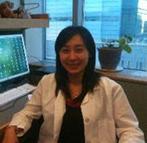



Professor, Institution of Immunology,School of life sciences
University of Science & Technology of China
Tel: 0551-63607897
Email: baili@ustc.edu.cn/
Homapage:
Research interests
1) Contributions of different APCs to NKT cells function.
Several variants of NKT cells ligands have been used to modulate the ratio of Th1/Th2 responses, develop new therapeutic strategies. The mechanisms are not well known. We have some results suggest that, different contributions from different APCs (antigen presenting cells) to NKT cells activation could be one of those reasons causing different immune responses. The purpose of study is to understand different role of APCs in NKT cell activation.
2) Formation of immune synapse.
Events happen at the T cells / APCs interface (immune synapse) are crucial for T cell activation. With both in vivo and in vitro imaging approaches, we will directly visualize the synapse formation and NKT cells activation, dissect molecular events happened at the NKT/APCs interface during synapse formation.
3) NKT cells function in liver and adipose tissue inflammation.
Obesity related chronic inflammation in liver and adipose tissue underlies insulin resistance (one of the reasons for type 2 diabetes). It has been reported that, macrophages, CD4+, CD8+ T cells and Tregs are involved in these tissue inflammation. The abundance of NKT cells in liver and their important regulatory function suggest, NKT cells may also be involved in these obesity related chronic inflammation. Our interest is to demonstrate the role of NKT cells inobesity related chronic inflammation.
Selected Publications
1.Bai L, Sagiv Y, Liu Y, Freigang S, Yu KO, Teyton L, Porcelli SA, Savage PB, Bendelac A. Lysosomal recycling terminates CD1d-mediated presentation of short and polyunsaturated variants of the NKT cell lipid antigen aGC.Proc Natl Acad Sci U S A. 2009 Jun 23;106(25):10254-9.
2.Bai L, Wang Y, Fan J, Chen Y, Ji W, Qu A, Xu P, James DE, Xu T. Dissecting multiple steps of GLUT4 trafficking and identifying the sites of insulin action. Cell Metab. 2007 Jan; 5(1): 47-57.
3.Bai L, Dan Zhu, Keming Zhou, Wei Zhou, Dongdong Li, Yan Wang, Rongying Zhang and Tao Xu. Differential properties of GTP- and Ca2+-stimulated exocytosis from large dense core vesicles. Traffic. 2006 Apr; 7(4): 416-28.
4.Jiang L, Fan J, Bai L*, Wang Y, Chen Y, Yang L, Chen L, Xu T. Direct Quantification of Fusion Rate Reveals a Distal Role for AS160 in Insulin-stimulated Fusion of GLUT4 Storage Vesicles. J Biol Chem. 2008 Mar 28; 283(13): 8508-16.(co-first author)
5.Li CH, Bai L*, Li DD, Xia S, Xu T. Dynamic tracking and mobility analysis of single GLUT4 storage vesicle in live 3T3-L1 cells. Cell Res. 14(6), (2004),480-6. (co-first author)
6.Yuval Sagiv, Li Bai, Datsen G. Wei, Reuven Agami, Paul B. Savage, Luc Teyton, and Albert Bendelac. A distal effect of microsomal triglyceride transfer protein deficiency on the lysosomal recycling of CD1d. J Exp Med. 2007 Apr 2.
 Back
Back